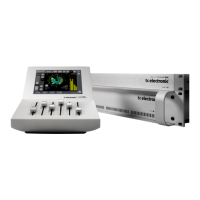46
MD-4
Setup
Configuration
Range: Stereo, Dual Mono, Stereo MS, Sum Mono, Left
Mono or Right Mono.
When set to Stereo, the L and R channels use the same
Delay,Trim,EQandMultibandsettings.Additionally,theL
andRsidechainsoftheMultibandsectionarelinked.
When set to Dual Mono, the channels can have different
Delay,Trim,EQ,MultibandandLimitsettings.TheLand
RsidechainsoftheMultibandsectionareunlinked.NoteA
and B labels on meters and channel selectors.
When set to Stereo MS, a stereo input is converted and
processed as M and S. Note M and S labels on meters
andchannelselectors.ThisallowsindividualTrim,EQand
Multiband processing to be applied to M and S elements of
thesignal,beforeit’sconvertedbacktostereoL/Ratthe
output. In this mode the sidechains of the Multiband section
areunlinkedsoMandSelementscanbeprocessed
completely independently.
When set to Sum Mono, a 2 channel or stereo input is
summed with the levels set on the Main page Trims,
at a relative phase of 0 degrees (normal mono) and 48
bit resolution. The summed signal can have different
processingappliedthroughtheuseofEQ,Multiband
processing and Limiting. Note A and B labels on meters
and channel selectors.
L Mono and R Mono provide modes where only one of the
input channels is passed to both outputs. The one signal
can have different processing applied through the use
ofEQ,MultibandprocessingandLimiting.NoteAandB
labels on meters and channel selectors.
The Configuration control affects the routing and
sidechainlinkingofthe5-bandsection.Linkingof
the Limiter is unaffected by the Configuration, but is
independently set on the Limit page.
Reference Level
Range:-24to0dBFS
This control provides an absolute Reference Level for the
Threshold settings in the Multiband section. Therefore, it is
the level at which the Compressor starts operating when
itsthresholdissetto0dB,seeleveldiagram.Whenthe5
Band mode is set to DXP, Reference Level is the level at
which the bands hit unity gain, regardless of their Steer
and Threshold settings. See level diagram.
Foruseinbroadcastandfilmproduction,normalReference
Levelsettingswouldbe-18dBFSinsomecountries,
and-20dBFSinothers.FormasteringtowardsaFull
Scale delivery, a setting between -14 (wide dynamic range
output)and-6dBFS(lowdynamicrange)wouldbe
more typical.
Ifyou’reworkingwithanaloginputsoroutputs,
remember to scale the converters to match the
surroundingequipment.LevelintheEnginesof
System 6000 are always expressed in absolute
digitallevel,dBFS.GototheFrame-I/O-Slotpagesto
checktheanalogsettings.Examples:IfLevelInandLevel
Out are set at 18 dBu, a Reference
Levelat-20dBFSwillbereachedatananaloglevelof-2
dBu. If Level In and Level Out are set at 24 dBu, the same
ReferenceLevelsettingwillbereachedat+4dBu.
When mastering with DXP mode, start with a
ReferenceLevelaround-8dBFS.Thiswillensure
thatloudpartsarenotsubjectedtoexcessivegain
and therefore limiting. When all other parameters
havebeenadjustedtocomplementthematerial,try
altering the Reference Level up and down a couple
ofdBtosettheoptimumaverage/peakratioofthat
particular piece of material.
5 band
Mode
Range: This is a powerful control that changes between
three different ways of using MD4. Please familiarize
yourself with the virtues of each individual mode.
Normal mode
The Normal mode is a standard, five-band, downward
compressor, where material over a certain Threshold will
be more and more affected by the compressor, finally to
be limited when a second threshold is exceeded. Preset
examplescanbefoundinEngineFactoryBank10,decade
4.MD4’s48bitarchitecturecandeliversubtlecompression
individually applied to different frequency bands and/or
different positions of a stereo image.
Usedonsinglesources,NormalModecanbeusedto
punchupakickorasnaredrumbyusingafairlylong
attackandfairlyfastreleasetime.Theattacktimeandthe
amount of compression can have a big effect on how well
thesignalishandledbysmallspeakers(ghettoblasters,
car-fi,bookshelfenclosuresetc).
Normal mode may be used with good results on other pop/
rocksourcesforcompressionandspectralcontrol,for
instance with vocal, sax, guitar, bass etc.
TheThresholdofthe5-banddownwardcompressor
inNormalModeissetonthe5Bandpage,and
relative to Reference Level on the Setup page. If
ReferenceLevelissetat-8.0dBFS,andthe
Threshold of a particular band is set at -6.0 dB, the
absoluteThresholdofthatbandwillbe-14.0dBFS.
Parallel mode
The Parallel Mode is a true, five-band upward compressor,
where material above a certain Threshold is less and less
affected by the Compressor. Preset examples can be found
inEngineFactoryBank10,decade4.
On analog consoles, parallel channels are often employed
to help control low level aspects of, for instance, vocal or
bass. MD-4 allows using the same technique in the digital
domain,wherethe“dry”partofthesignalisalwaysdelay
compensatedwiththesameamountasthelook-ahead

